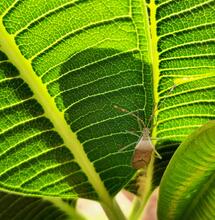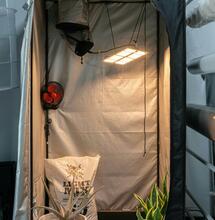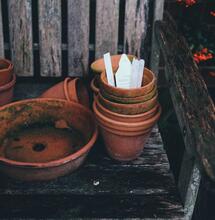How to recycle plant residues into compost

Those who use earth substrates to grow marijuana are already familiar with vermi-compost, as it is often contained in the substrate. Worms utilise plant residues to produce compost. We would like to exploit this principle to our advantage.
Actually, purchasing vermi-compost is much simpler than producing some in a worm farm. However, setting up your own worm farm could make sense, as organic residues to feed it would normally abound; i.e. in a worm farm, besides the usual organic ingredients, plant residues are easily ‘digested’ by worms. Many are not aware that they can dispose of all these residues with a minimum of risk. Worms eat anything, and there are worm farms that do not produce waste at all, whether in a living space or on a balcony. In the best worm farms, in addition to worm compost, worm juice is also produced. These farms have taps to extract worm juice. Worm juice contains many precious nutrients, which are not exclusively meant for marijuana plants. [caption id="attachment_7039" align="alignnone" width="500"] A 20-litre bucket, three 11-litre pots, silage film, repair tape.[/caption]
Operating a worm farm
Beginners, who need further experience, should first select a good worm farm kit. At a later date, with additional experience, they could set up a worm farm based on their personal taste and in a suitable size. In addition to housings for a worm farm, kits contain a starter feed, a mix of minerals and coconut-fibre mats or even hemp-fibre mats to be used as cover. Compost worms are supplied with the kit, which makes the worm farm easy to set up and put into operation. In order to operate a worm farm, it is not enough to feed it with organic residues only, as this would cause the worms to suffer a deficiency of minerals at some point in time. For this reason, it is crucial to regularly supply special minerals for worms, which will also be beneficial for plants at a later date. When a worm farm is put into operation, it is also important for worms to acclimate, so that they can increase in number and possibly survive beyond winter. For this reason, they should be fed with the appropriate feed mix and treated with the utmost care. For a Northern climate like Germany’s, the ‘hungriest’ and consequently best compost worms are Eisenia foetida. Other worm types that are sold in Germany survive temperatures of 0 to 30°C, but prosper most comfortably – and are, consequently, particularly active – at temperatures of 15 to 25°C. Below 10° Celsius, compost worms would tend to eat less and be less active. When the temperature is either too low or too high, they will die. The cocoons, which are especially produced in the cooler autumn season, tend to survive from minus 2 to 38°C. [caption id="attachment_7040" align="alignnone" width="500"] Hold the pot, mark it, cut the intersection.[/caption] This means that you cannot set up a worm farm in a room or outdoor space that could reach a temperature above 30°C. In winter, your worm farm should be placed in a sheltered space. Hemp mats used as covers prevent the surface from drying out, worms from escaping or even fruit flies from reaching the worm farm, while ensuring that the worm farm ‘breathes’ and remains insulated during winter. In summer, during hot days, hemp covers should be moistened to cool down the temperature and prevent evaporation. Hemp does not decompose directly, which makes hemp mats particularly suitable. In any case, newspapers could also be used as covers. A few kits also include hemp mats made to measure as covers. They can be laid over one another for cooling or insulation purposes. In addition, during winter, coffee grounds can be mixed with lettuce leaves or similar organic matter and placed in the worm compost, in order to produce warmth through the decay of organic residues.
The worm farm concept
A typical worm farm consists of four elements, three of which are exactly similar. You start building a worm farm with a floor element, which is the same as the other three but is not pierced. A tap is embedded at the very bottom of it, in order to collect worm juice. It can be used to place medium-sized old clay pots on top it. A gap should be left with the next element. This latter element will be pierced at its bottom in several points with an 8-mm drill bit, for liquids to drip out and for worms to move to a higher level. In addition, in the upper part of side walls, small holes can be pierced to favour aeration. Since the action of worms is also aided by that of micro-bacteria, a sufficient quantity of oxygen needs to reach at least the upper layer, which hosts active life. Three pierced boxes are needed. The first pierced box is set up as a starter box in the lowest level. The next step is to form a ‘base’ with a layer of crushed cardboard, newspapers, autumn leaves and hay in the pierced starter box. The full surface is pre-moistened and regularly kept moist, and a few worms are added to the mix. A minimum of 1,000 to 2,000 compost worms will be placed on top. Above this base, after two to four days, suitable organic waste will be added. Each time the surface needs to be covered with newspapers or a hemp mat. When the worm farm is in operation, with daily or nearly daily feeding, the biomass layer should measure 2 to 4 cm. [caption id="attachment_7041" align="alignnone" width="500"] There is a spacer at the bottom of the bucket, on top two polystyrene disks made to measure and wedged into each other are fitted.[/caption] Every day Eisenia foetida worms eat the same quantity of organic residues as their body weight; other compost worms eat slightly smaller quantities. All worms need to be fed regularly. However, they can even survive without food for one week. Users who are away on trips of up to three weeks, can mix a weekly ration of moistened feed with newspaper clippings. After supplying feed, this needs to be covered with a newspaper. It will take two to three months for the worm farm to reach stable operation. Feed will have to be supplied regularly until the first pierced box is full, then a second box can be placed on top, in order to continue to supply feed. Through holes, worms will creep to upper levels. When the second layer is also full, then a third layer can be placed. When this is also full, the first pierced box can be removed, emptied and placed empty on top of the last box. The removed worm compost can be sieved and used or stocked.
Worm juice and worm compost
The worm juice should be removed regularly, for it not to stagnate in the first pierced box. It can be diluted in a proportion of 1 to 10 and used for irrigation. The worm compost can be mixed with earth, equally in a proportion of 1 to 10. For indoor marijuana, a mixture containing earth, perlite and worm compost in a proportion of 2:1:2 or even 1:1:1 is recommended. When plants are left in place for a long time, this compost can be laid on the soil later. In addition to nitrogen, phosphorus and potassium, the compost contains magnesium, calcium and other trace elements, as well as valuable microbes that are particularly good for plants. If not so many nutrients are left in the used soil after harvest, this soil can be enriched several times with worm compost and reused. For plant growing, however, an enzyme preparation is also needed, which will aid the decomposition of dead roots, in order to make the used soil suitable for the next plants. [caption id="attachment_7042" align="alignnone" width="500"] A pot in the bucket with a drain opening on a wheeled board, drain holes stuffed with kitchen paper, feed and worms in the front.[/caption]
Feeding
Worms should be fed regularly. For this reason, you should consider using a method to shred newspapers, cardboard or even hay, leaves, garden waste and obviously hemp residues in the easiest way. The smaller shreds are cut the better, as worms will digest the organic residues quicker. Coffee or tea grounds or a coco substrate are easily eaten by worms. If you feed worms with coco fibres, all other nutrients should be flushed out in advance. All parts should be no bigger than a fingertip. No metal clips, glossy paper, shipping labels or adhesive tapes should be mixed to the paper or cardboard shreds used in a worm farm. Up to 20% of paper and cardboard is enough for worms and at least a part should be mixed with the feed, for the worms to benefit from a varied diet. In autumn, a quantity of foliage can be stocked. If you leave lawn cuttings to dry out in the sun, you can also use them in your worm farm. Eggshells –suitably washed and crushed with a rolling pin – are also good. Worms will easily eat fruit and vegetable leftovers or, occasionally, stale bread crumbs. Excessively dry feed should first be moistened. If the box is too wet, paper clippings can be mixed in it. If the box is too dry, the mix can be moistened with a pump sprayer. Obviously, you should avoid supplying citrus fruit, leek, glossy paper, nutshells, or any uncooked, salted or marinated food, chemicals, plastics, onions, garlic, meat, cheese, fat-rich food and any similar organic matter. If parts of the feed develop moulds, these parts can be simply removed superficially from the worm compost already produced. Alternatively, mouldy feed should be disposed of. Worms are even used in wastewater treatment plants for the decontamination of sludge. However, no patently toxic or inappropriate feed should be supplied. Consequently, cat litter and dog excrements are not advisable. However, for larger worm farms, horse manure is frequently used. [caption id="attachment_7043" align="alignnone" width="500"] Some forest soil with leaves, moistened feed and, in the front, worms.[/caption]
Proper operation
Over time, worm farms undergo acidification. These toothless worms are also able to grind feed that is mixed with pebbles and fine gravel in their stomach. For this reason, it is advisable to always supply, in addition to organic residues, small quantities of basal rock dust, aglime or an appropriate mineral mix. In a box with 2,000 compost worms, it suffices to add a full tablespoon of basal rock dust every three weeks (to be spread all over the box). Normally, if the worm farm is slightly scented, this means its active layer is probably not receiving sufficient air, or that too much feed has been supplied and anaerobic decomposition is taking place. To remedy this, the supply of feed should be reduced and the pH value should also be tested. The best way to do it is to collect soil samples from four different spots. A small glass should then be half filled with soil and half filled with distilled water, and then everything should be mixed up. Only then should the pH value be measured to check whether it is in the range of 5 to 7. If the tested pH value is below 5, aglime should be supplied in order to raise it. After two to three weeks, it will be clear whether the addition of aglime has been effective. Care should be taken not to raise the pH value too much. A low pH value with acrid smell indicates a build-up of ammonia, which in turn points to anaerobic decomposition in the worm farm. To remedy this, better aeration should be favoured, the worm compost should be broken up into tinier pieces and fed with egg-carton, cardboard or newspaper pieces until the problem is fixed. An air shortage is probably due to a high humidity level, in which case, dry cardboard, dry newspaper pieces or dry hay should be added to the mix. [caption id="attachment_7044" align="alignnone" width="500"] Not all garden worms are the right ones.[/caption] If the pH value rises above 7.5, you should deliberately avoid adding fruit, and check that no fruit is contained in the feed. Since newspapers and cardboard packages are soaked by feeding, you should check that the water content is initially equal to a 5.5 pH value and that only small quantities of fruit residues are fed. If large quantities of fruit residues have been supplied, a little more mineral mix, basal rock dust or aglime should be added in order to adjust acidity. If you realise that the worm farm is too dry, then add water. To check if worm humus is sufficiently dry, take it by your hands and squeeze it a bit, no water should flow out. But it should also not be excessively dry.
General information on compost worms
Worms live in symbiosis with microorganisms. These microorganisms macerate the feed and are eaten by worms together with small parts of feed. Compost worms live as long as 15 years, breathe through their skin, have five hearts and, as hermaphrodites, produce up to 200 cocoons in a year. In the breeding season, the ring around worms comes off, is fecundated and develops into a cocoon. At a cooler temperature, the cocoon production rises, which ensures the appearance of new worms in spring. When the space is narrower, or food is available in short supply, or when the temperature is too warm, worms’ reproduction will fall. Worms do not stand the light und are able to burrow themselves quickly, if you remove the cover, or the hemp mat, from the upper box. [caption id="attachment_7045" align="alignnone" width="500"] Initial feed supply, worms are still vital.[/caption]
Other ‘fellow occupants’
If you fail to cover your worm farm with a hemp mat, when you supply fruit residues to it, your box will become infested with fruit flies. This is particularly annoying in indoor spaces, where you run the risk of infestation of both the worm compost and your grown plants with flies or gnats. In addition to covering the worm farm, you could obviate the problem by supplying less fruit residues, or wrap them up in newspaper and bury them under the surface. For preventive purposes, you can also make your own fruit fly trap by mixing one part apple juice, two parts of vinegar and two drops of dishwashing liquid and supplying it to the farm. Fruit flies will drown in this liquid. When flies proliferate, you can starve them out by only feeding cardboard and a small quantity of mineral powder. Worms will survive. Against gnats, you can use nematodes or predatory mites (Hypoaspis aculeifer). If you regularly supply fruit residues to a worm farm and it is too dry, it will also become infested by ants. These sweet residues can still be left in place. When the problem arises, you can wrap up the residues in a newspaper and bury them under the worm compost. Make sure you moisten the surface regularly with a pump sprayer. [caption id="attachment_7046" align="alignnone" width="500"] Hello, city of Münster, where is the rubbish?[/caption] White worms, measuring 5 to 30 mm in length, named enchytraeids will also grow in almost every worm farm. If they exceed the number of compost worms, this means that the pH value is too low and should be increased. Springtails, measuring 1 to 5 mm and with six feet, may also frequently appear. Much less common guests are the smaller black woodlice with 14 feet. These can easily be picked up by hand. These three types of guests contribute to the decomposition of organic feed.
In conclusion
If a worm box has a sufficient quantity of worms, which however are not eating enough, this means that the temperature is probably too cold or too warm. When the number of worms falls, this means that there is a probable lack of trace elements. You should proceed with a pH test and supply aglime, basal rock dust or a mineral mix. There could be excessive dryness in the box for worms to proliferate or, in rare cases, there could be too much nitrogen. In a few parts, worms could be very thin and smelly. The nitrogen concentration in the feed should be reduced. You will learn what the right environment for your worm farm is over time, as you normally do with your grow room, and you will no longer get it wrong. [caption id="attachment_7048" align="alignnone" width="500"] Ready worm compost sold on the market.[/caption]
About pictures in this article
These pictures show an up-cycling process, in which neither the bucket nor the pots were damaged and the worm juice was tipped out after the removal of pots. In this test, only a few garden worms were doing well after nearly two weeks. A few self-made worm farm constructions are inappropriate. Only time will tell if a self-made construction is good. Text: Robert B.



.png)